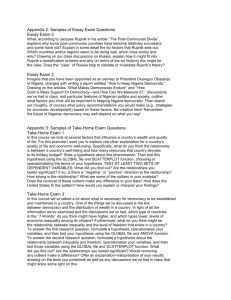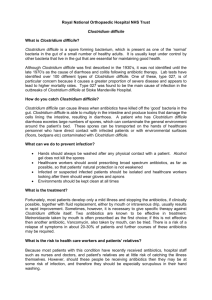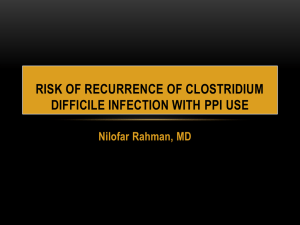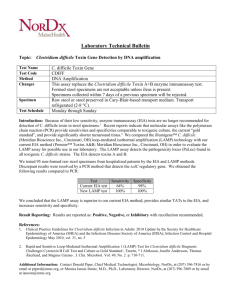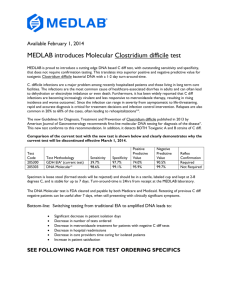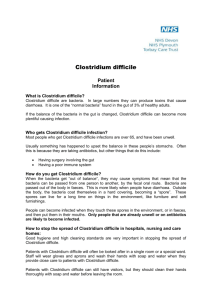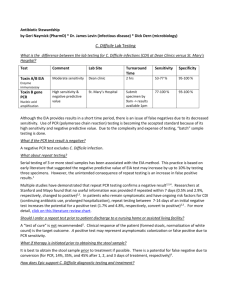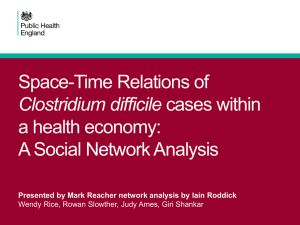Selected publications
advertisement
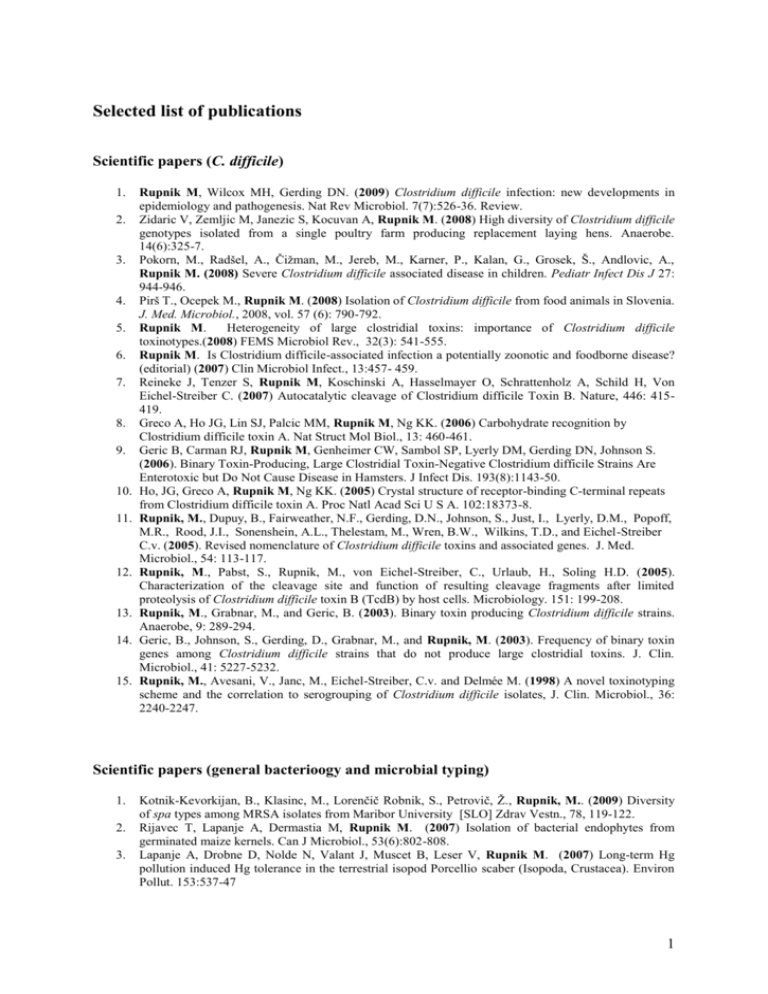
Selected list of publications Scientific papers (C. difficile) 1. 2. 3. 4. 5. 6. 7. 8. 9. 10. 11. 12. 13. 14. 15. Rupnik M, Wilcox MH, Gerding DN. (2009) Clostridium difficile infection: new developments in epidemiology and pathogenesis. Nat Rev Microbiol. 7(7):526-36. Review. Zidaric V, Zemljic M, Janezic S, Kocuvan A, Rupnik M. (2008) High diversity of Clostridium difficile genotypes isolated from a single poultry farm producing replacement laying hens. Anaerobe. 14(6):325-7. Pokorn, M., Radšel, A., Čižman, M., Jereb, M., Karner, P., Kalan, G., Grosek, Š., Andlovic, A., Rupnik M. (2008) Severe Clostridium difficile associated disease in children. Pediatr Infect Dis J 27: 944-946. Pirš T., Ocepek M., Rupnik M. (2008) Isolation of Clostridium difficile from food animals in Slovenia. J. Med. Microbiol., 2008, vol. 57 (6): 790-792. Rupnik M. Heterogeneity of large clostridial toxins: importance of Clostridium difficile toxinotypes.(2008) FEMS Microbiol Rev., 32(3): 541-555. Rupnik M. Is Clostridium difficile-associated infection a potentially zoonotic and foodborne disease? (editorial) (2007) Clin Microbiol Infect., 13:457- 459. Reineke J, Tenzer S, Rupnik M, Koschinski A, Hasselmayer O, Schrattenholz A, Schild H, Von Eichel-Streiber C. (2007) Autocatalytic cleavage of Clostridium difficile Toxin B. Nature, 446: 415419. Greco A, Ho JG, Lin SJ, Palcic MM, Rupnik M, Ng KK. (2006) Carbohydrate recognition by Clostridium difficile toxin A. Nat Struct Mol Biol., 13: 460-461. Geric B, Carman RJ, Rupnik M, Genheimer CW, Sambol SP, Lyerly DM, Gerding DN, Johnson S. (2006). Binary Toxin-Producing, Large Clostridial Toxin-Negative Clostridium difficile Strains Are Enterotoxic but Do Not Cause Disease in Hamsters. J Infect Dis. 193(8):1143-50. Ho, JG, Greco A, Rupnik M, Ng KK. (2005) Crystal structure of receptor-binding C-terminal repeats from Clostridium difficile toxin A. Proc Natl Acad Sci U S A. 102:18373-8. Rupnik, M., Dupuy, B., Fairweather, N.F., Gerding, D.N., Johnson, S., Just, I., Lyerly, D.M., Popoff, M.R., Rood, J.I., Sonenshein, A.L., Thelestam, M., Wren, B.W., Wilkins, T.D., and Eichel-Streiber C.v. (2005). Revised nomenclature of Clostridium difficile toxins and associated genes. J. Med. Microbiol., 54: 113-117. Rupnik, M., Pabst, S., Rupnik, M., von Eichel-Streiber, C., Urlaub, H., Soling H.D. (2005). Characterization of the cleavage site and function of resulting cleavage fragments after limited proteolysis of Clostridium difficile toxin B (TcdB) by host cells. Microbiology. 151: 199-208. Rupnik, M., Grabnar, M., and Geric, B. (2003). Binary toxin producing Clostridium difficile strains. Anaerobe, 9: 289-294. Geric, B., Johnson, S., Gerding, D., Grabnar, M., and Rupnik, M. (2003). Frequency of binary toxin genes among Clostridium difficile strains that do not produce large clostridial toxins. J. Clin. Microbiol., 41: 5227-5232. Rupnik, M., Avesani, V., Janc, M., Eichel-Streiber, C.v. and Delmée M. (1998) A novel toxinotyping scheme and the correlation to serogrouping of Clostridium difficile isolates, J. Clin. Microbiol., 36: 2240-2247. Scientific papers (general bacterioogy and microbial typing) 1. 2. 3. Kotnik-Kevorkijan, B., Klasinc, M., Lorenčič Robnik, S., Petrovič, Ž., Rupnik, M.. (2009) Diversity of spa types among MRSA isolates from Maribor University [SLO] Zdrav Vestn., 78, 119-122. Rijavec T, Lapanje A, Dermastia M, Rupnik M. (2007) Isolation of bacterial endophytes from germinated maize kernels. Can J Microbiol., 53(6):802-808. Lapanje A, Drobne D, Nolde N, Valant J, Muscet B, Leser V, Rupnik M. (2007) Long-term Hg pollution induced Hg tolerance in the terrestrial isopod Porcellio scaber (Isopoda, Crustacea). Environ Pollut. 153:537-47 1 4. 5. 6. Lapanje, A., Rupnik, M., Drobne, D. (2007) Gut Bacterial Community Structure (Porcellio Scaber, Isopoda, Crustacea) As A Measure Of Community Level Response To Long-Term And Short-Term Metal Pollution. Environ. Toxicol. Chem., 26, ( 4):. 755-763. Cankar, K, Kraigher, H, Ravnikar, M, Rupnik, M. (2005). Bacterial endophytes from seeds of Norway spruce (Picea abies L. Karst). FEMS Microbiol Lett., 244: 341-345. Drobne, D., Rupnik, M., Lapanje, A., Strus, J. and Janc, M. (2002) Isopod gut microflora parameters as endpoints in toxicity studies. Environ. Toxicol. Chem., 21: 604-609. Book Chapters 1. 2. 3. Rupnik M., Just I., (2006) Large clostridial cytotoxins modifying small GTPases. In Sourcebook of Bacterial Protein Toxins (J. Alouf, M. Popoff, eds.), p.409- 429, Elsevier. Kostanjšek, R., Štrus, J., Lapanje, A., Avguštin, G., Rupnik, M., Drobne, D. (2006) Intestinal microbiota of terrestrial isopods. V: König, H., Varma, A. (eds.). Intestinal microorganisms of termites and other invertebrates, (Soil biology, 6). Berlin: Springer, pg. 115-131. Rupnik, M. (2009) Molecular variability in clostridium difficile large clostridial toxins. V: Brüggemann, Holger, Gottschalk, Gerhard (eds.). Clostridia : molecular biology in the post-genomic era. Norfolk, UK: Caister Academic Press, pg. 131-142. 2

